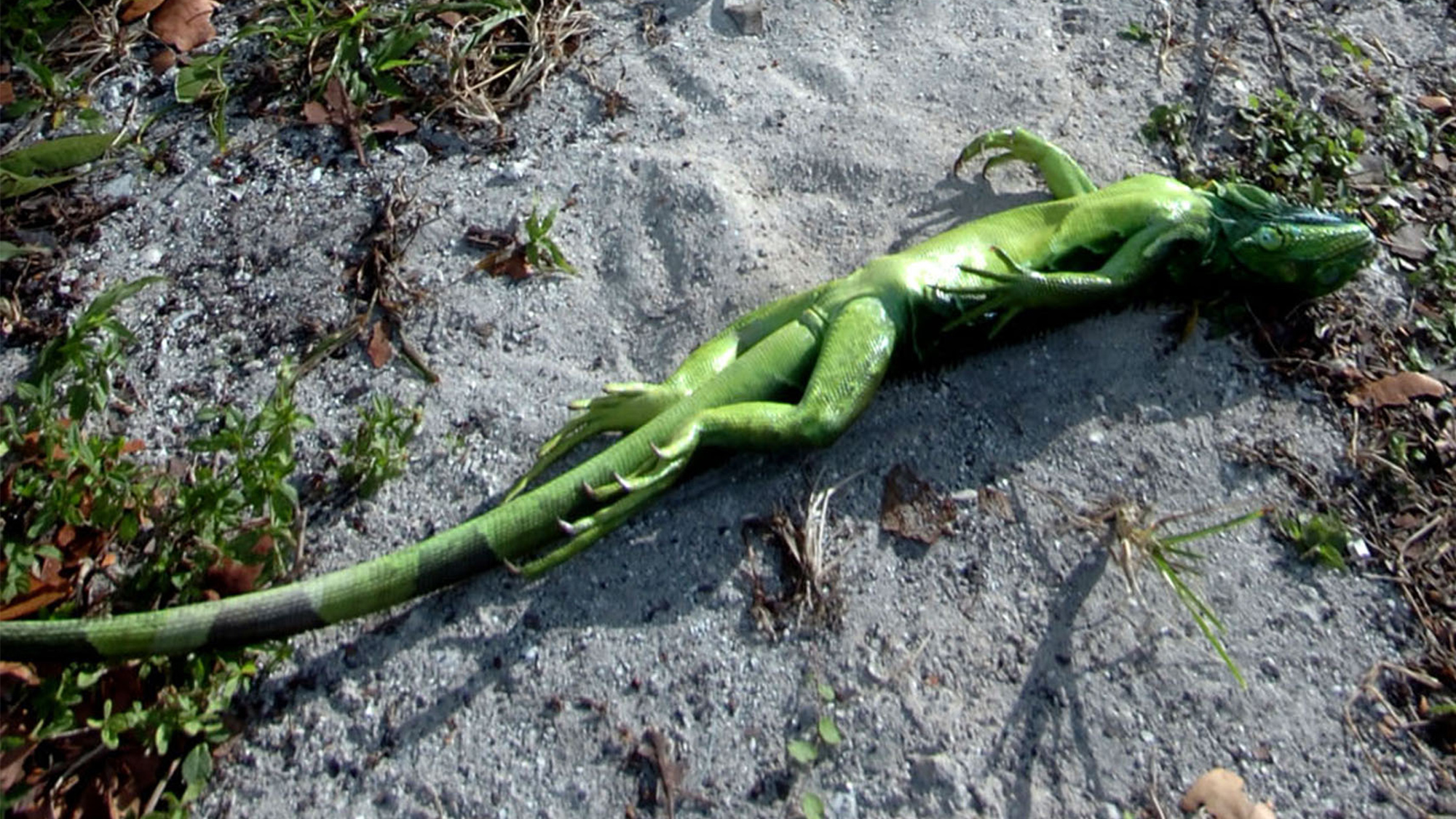Florida weather forecast: Cloudy with a chance of falling iguanas
When temperatures tumble, so do iguanas.
Jan 21 - This isn't something we usually forecast, but don't be surprised if you see Iguanas falling from the trees tonight as lows drop into the 30s and 40s. Brrrr! #flwx #miami pic.twitter.com/rsbzNMgO01January 21, 2020
Chilly winter weather brings a chance of snow, ice ... and falling iguanas? It does in Florida, according to the National Weather Service (NWS).
On Tuesday (Jan. 21), predictions of low temperatures in southern Florida prompted NWS Miami to issue an unusual warning in a tweet: "Falling Iguanas Possible Tonight."
However, those tumbling lizards won't be dead, merely stunned by the cold. When temperatures dip into the 40s (degrees Fahrenheit) or lower (single digits in degrees Celsius), iguana metabolisms slow down so much that the animals become immobile and can drop out of trees; prior historic cold snaps in the southern part of the Sunshine State led to bouts of "raining iguanas" in 2008 and 2018, Live Science previously reported.
Related: See Photos of the World's Most Bizarre Lizards
"This isn't something we usually forecast, but don't be surprised if you see Iguanas falling from the trees tonight as lows drop into the 30s and 40s. Brrrr!" NWS representatives tweeted.

Iguanas — and most reptiles — are ectothermic, which means they rely on external temperatures to regulate their own body temperatures. If the weather becomes too cold, iguanas enter a state known as torpor, a type of hibernation in which they conserve precious heat by dramatically slowing down their metabolic functions.
In a video clip shared on Twitter yesterday (Jan. 22) by Ginger Zee, chief meteorologist at ABC News, a frozen iguana plummets from a branch in Miami, its limbs stiff and immobile as it falls. At the time, the temperature was 33 F (1 C), Miami's coldest temperature in nine years, Zee wrote.
Sign up for the Live Science daily newsletter now
Get the world’s most fascinating discoveries delivered straight to your inbox.
IGUANAS officially fell... as did the temp in Miami. Down to 40 now, wind chill 33. Coldest temp in more than 9 years... don't worry, 80 is back Friday. 📸:@WPLGLocal10 h/t @SamWnek pic.twitter.com/DCNYLPGKyZJanuary 22, 2020
Eric Zerkel, a managing editor at the Weather Channel, noted on Twitter that a graphic in the NWS tweet resembled oven mitts, and he jokingly queried if people should wear mitts to try to catch falling iguanas. Zerkel asked the NWS to "Please advise," and the agency was quick to clarify that the mitts in the image were not for lizard catching.
"Those are more for covering your hands ... but interesting take. We didn't think of that!" they said in the tweet.
Green iguanas (Iguana iguana) are common in southern Florida, but they aren't native to the state and are recognized as an invasive species, according to the Florida Fish and Wildlife Conservation Commission (FWC). Male iguanas may grow to be up to 5 feet (1.5 meters) in length and can weigh up to 17 lbs. (8 kilograms); and females can lay up to 76 eggs at a time, the FWC says.
Once temperatures rise, the frozen iguanas' normal bodily functions should resume. Until then, people should leave the fallen, rigid lizards where they lie; iguanas can revive fairly quickly, as one Florida man found out to his dismay in 2018. He had collected a number of cold, stiff and seemingly dead iguanas and loaded them into his car, but soon after he was back on the road the lizards warmed up and "started running around," causing an accident, NPR reported.
- Images: Exotic Lizards Pop Out of the Ground in Florida
- Album: Bizarre Frogs, Lizards and Salamanders
- Image Gallery: Acrobatic Tricks of Lizards & Robots
Originally published on Live Science.


Mindy Weisberger is an editor at Scholastic and a former Live Science channel editor and senior writer. She has reported on general science, covering climate change, paleontology, biology and space. Mindy studied film at Columbia University; prior to Live Science she produced, wrote and directed media for the American Museum of Natural History in New York City. Her videos about dinosaurs, astrophysics, biodiversity and evolution appear in museums and science centers worldwide, earning awards such as the CINE Golden Eagle and the Communicator Award of Excellence. Her writing has also appeared in Scientific American, The Washington Post and How It Works Magazine. Her book "Rise of the Zombie Bugs: The Surprising Science of Parasitic Mind Control" will be published in spring 2025 by Johns Hopkins University Press.










